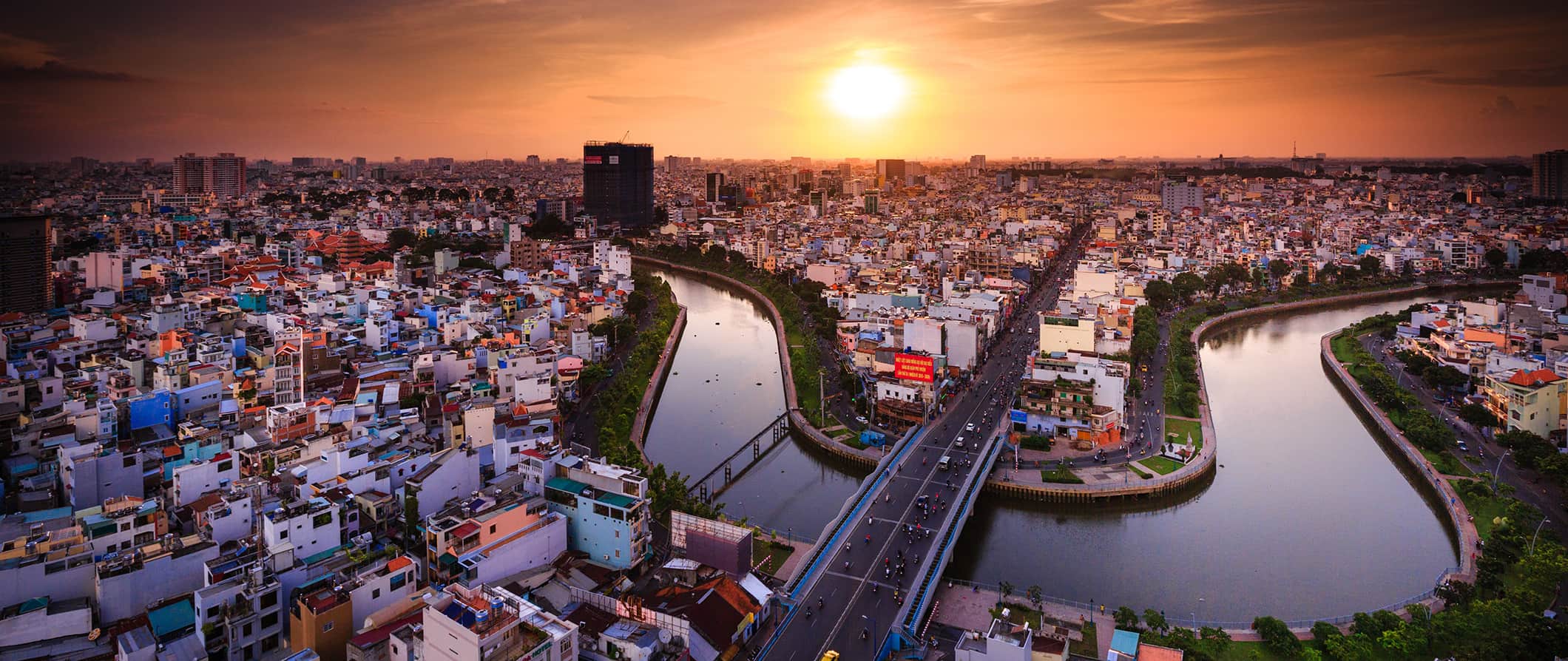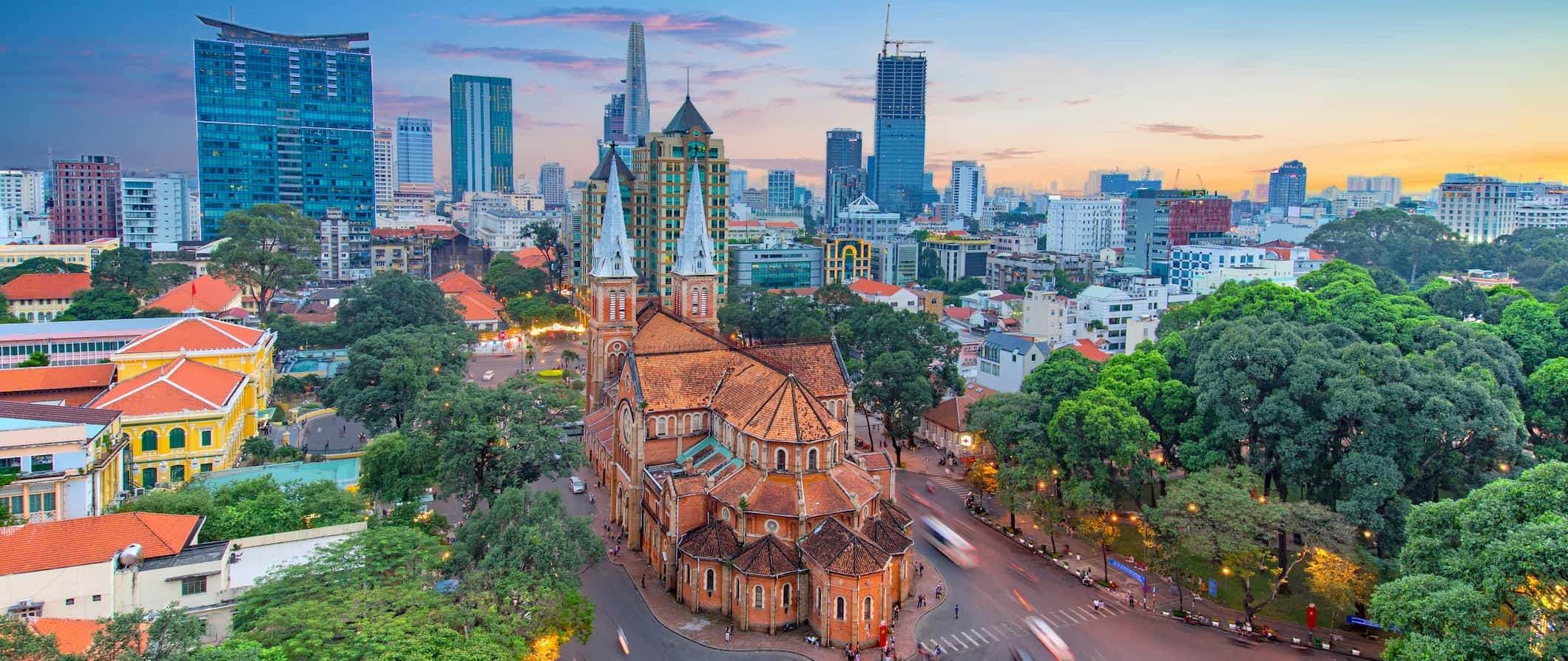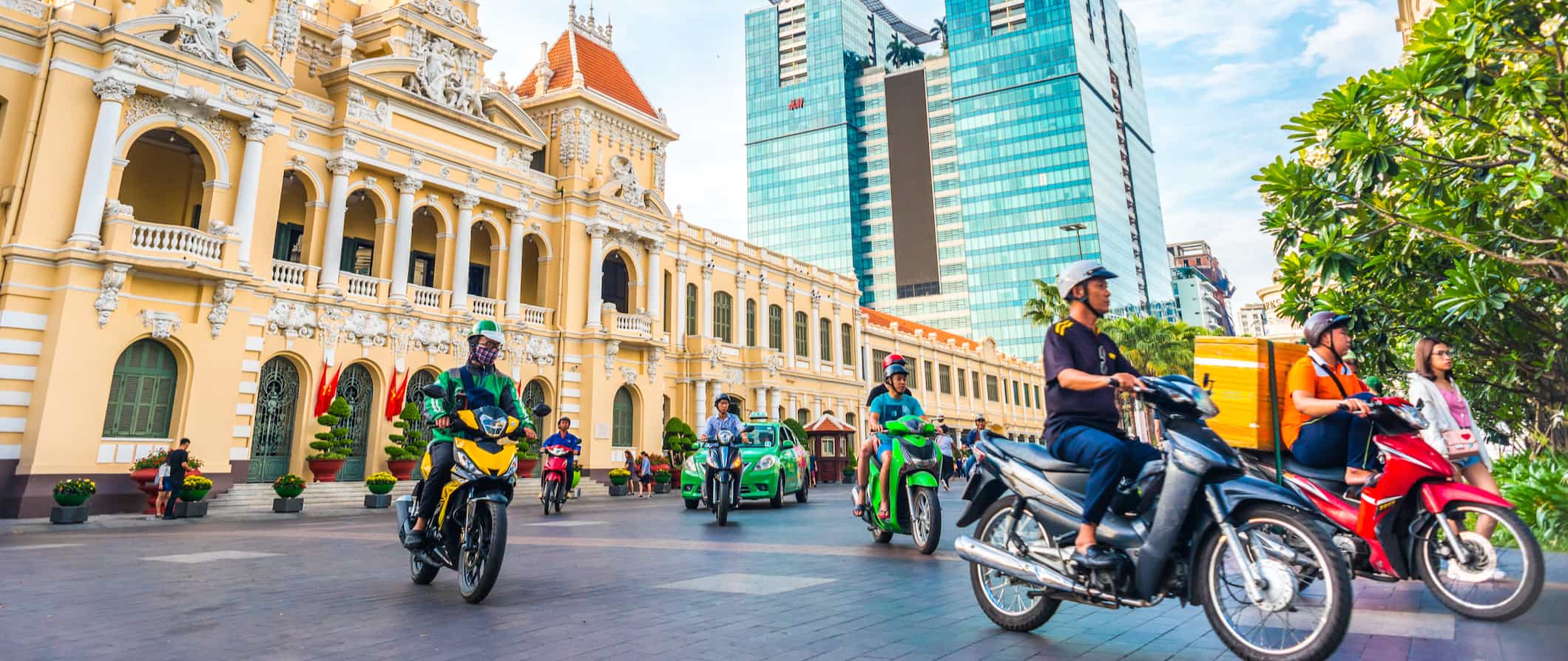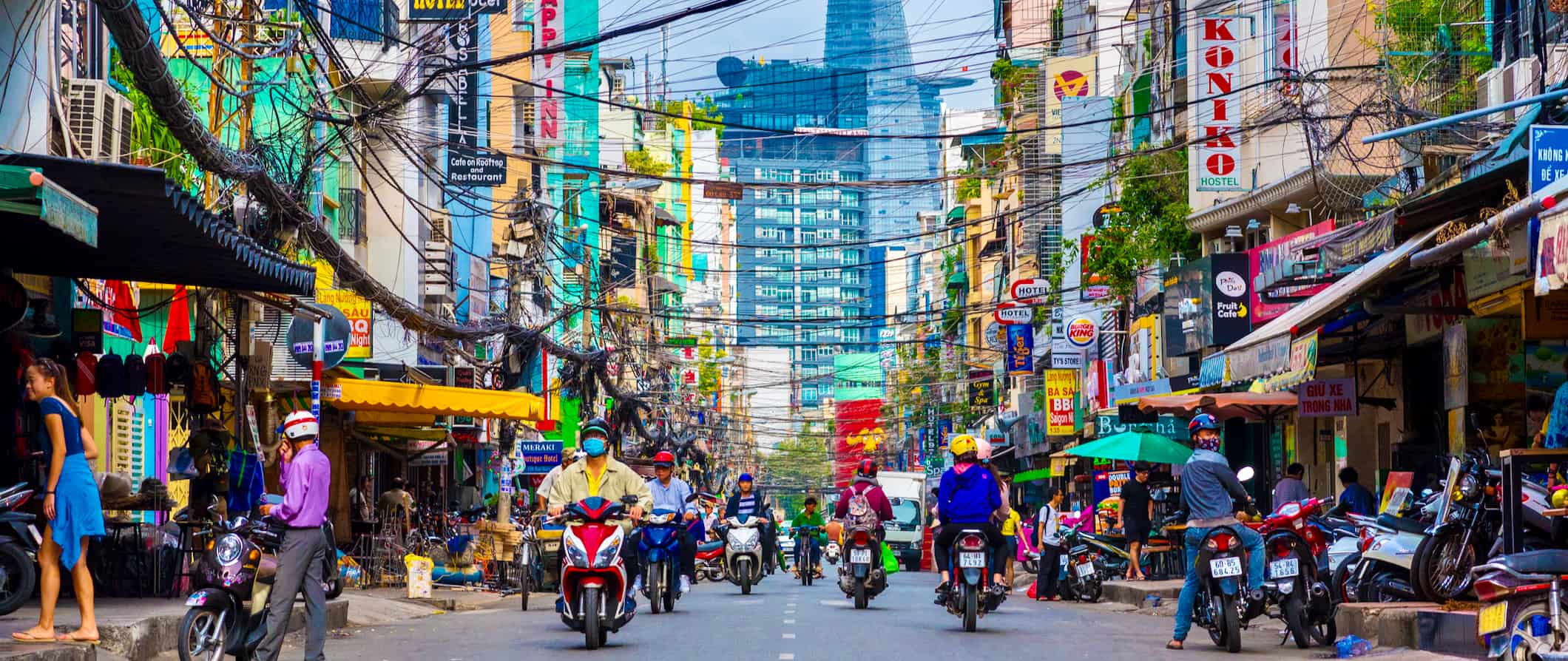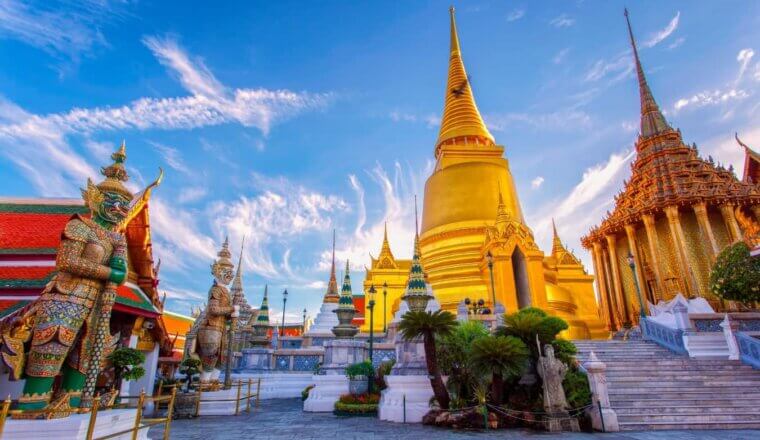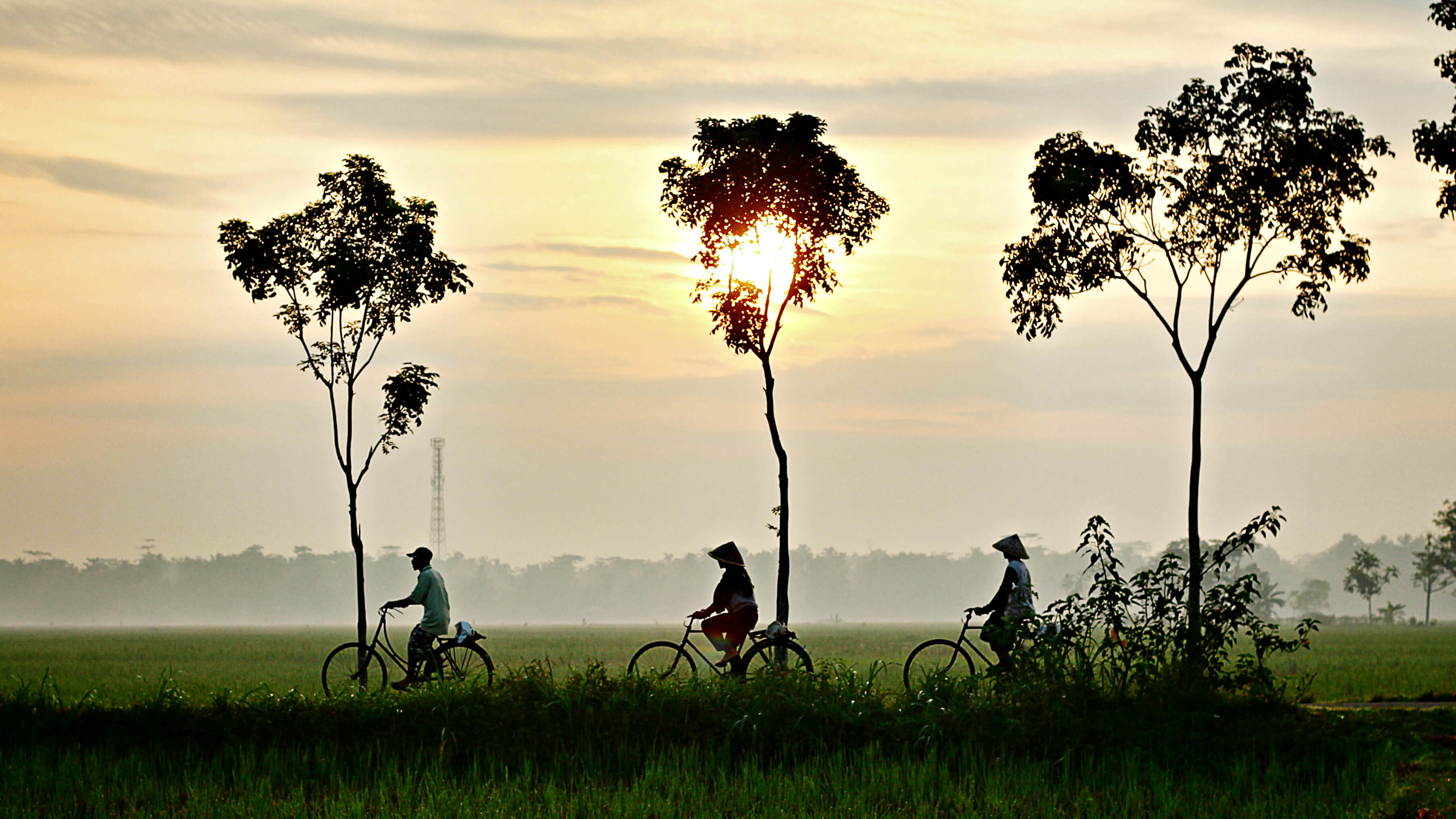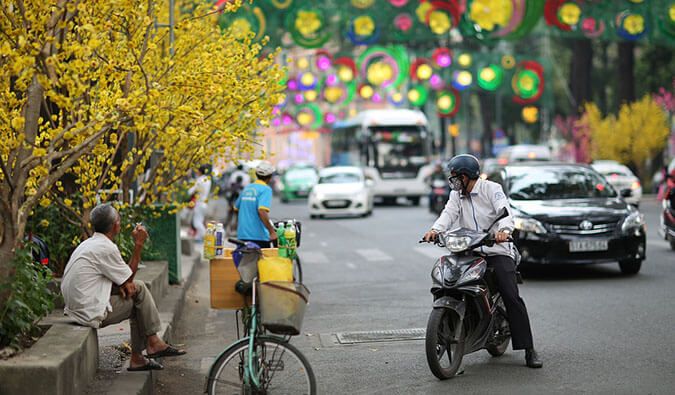Ho Chi Minh City (formerly known as Saigon, though all the locals still call it that) is the largest (and most chaotic city) in Vietnam. Motorbikes, bicycles, cars, and rickshaws go wherever they please, and lots of street stands and markets spill into the traffic lanes. It’s a city with a billion things happening at once.
It’s also one of the most popular destinations in the country and has recently evolved into a hotspot for digital nomads thanks to its cheap cost of living.
The city has a lot to offer: wonderful shops, fantastic nightlife, delicious food, and plenty of historic sites. Additionally, you’ll find some interesting (and propaganda-heavy) museums like the War Remnants Museum as well as the famous Cu Chi Tunnels, secret tunnels used by the Viet Cong during the Vietnam War. It’s my second favorite city in Vietnam (after Hoi An) and worth spending a few days visiting.
This travel guide to Ho Chi Minh can help you plan your trip, save money, and make the most of your time in this hectic metropolis!
Table of Contents
Top 5 Things to See and Do in Ho Chi Minh City
1. Admire the Notre Dame Cathedral
The Notre Dame Cathedral is an imposing red brick building built between 1877 and 1883 by the French. At nearly 58 meters (190 feet), the two towers in the front of the cathedral rise above visitors and the neon-lit statue of the Virgin Mary. The cathedral still functions as a religious site and a major tourist destination, especially after gaining international recognition for a supposed sighting of a teardrop falling from the Virgin Mary statue in 2005. (Note: The Notre Dame Cathedral is temporarily closed for renovations until 2023.
2. See the Cao Dai Holy See Temple
The Cao Dai religion (known as Caodaism) is relatively new (it’s less than 100 years old). It combines the teachings of several religions, including Buddhism, Taoism, and Confucianism. This Cao Dai temple is the main temple for the religion and is hugely ornate and colorful, with a giant globe behind the main altar displaying the religion’s “divine eye” symbol. Entrance is free but there are a few rules to follow when visiting. You will need to enter through the side door instead of the main door and be sure to keep your shoes outside. Men will need to use the door on the right side and women on the left. Most people combine a trip to the temple with the Cu Chi Tunnels excursion.
3. Crawl through the Cu Chi Tunnels
Here you can crawl through the extensive network of narrow tunnels used by the Viet Cong in the 1960s to fight American soldiers during the Vietnam War. Tours involve a walk-through of the tunnels (over 100 meters of tunnels are open to visitors) which give you a sense of how the Vietnamese were able to defend their country for so long against a stronger force. It’s a sobering experience and not one for anyone claustrophobic. Tours cost around 350,000 VND.
4. Ascend the Saigon Skydeck
For a 360-degree panorama of the city, head to the Saigon Skydeck, one of the tallest buildings in the country. The observation deck is on the 49th floor of the Bitexco Financial Tower and offers amazing views. Admission costs 200,000 VND and includes a bottle of water. Just check the weather forecast ahead of time. You can also go at night to see the city lit up. Open daily from 9:30am-9:30pm.
5. Take a food tour
To best learn about the local cuisine, take a tour through Ho Chi Minh’s best foodie neighborhoods. With Street Food Adventure Tours you can safely try lots of street food, including everything from rice vermicelli with BBQ pork to coconut juice and Vietnamese coffee (and more!). There are vegan and vegetarian food tours as well. Most of the tours are done via motorbike although there are a few walking tours listed on their website. Tours are typically around 820,000 VND. Just be sure to bring an appetite!
Other Things to See and Do in Ho Chi Minh City
1. Get lost in Chinatown
Chinatown is a hive of activity and a maze of temples, restaurants, jade ornaments, and medicine shops. Aside from the sprawling Binh Tay Market, you’ll find some fascinating temples in the area including the Chinese Chua Quan Am Temple and Cha Tam, a Catholic cathedral. It’s the biggest Chinatown in the country (there are around 500,000 Chinese people living in the city alone).
2. Visit the Ho Chi Minh City Museum
At one point or another, this city museum has been a Governor’s Palace, a committee building, and a Revolutionary Museum. Today, you’ll find a collection of weaponry and memorabilia from the country’s revolutionary struggle as well as captured U.S. fighter planes and tanks from the Vietnam War. Located in the former Gia Long Palace, there are some permanent exhibitions along with special exhibitions that rotate on a regular basis (check the website for details; it has an English version). Admission costs 30,000 VND plus 20,000 VND if you want to take photos.
3. See the Emperor Jade Pagoda
This temple was built in 1909 to honor the supreme Taoist god, Emperor Jade. It’s one of the most impressive pagodas in Vietnam. It’s also referred to as the Tortoise Pagoda and the pond on site is filled with turtles. The building is filled with intricate woodcarvings and statues of divinities and heroes, including Emperor Jade himself. The roof is also covered in detailed tile work showing characters from Buddhist and Taoist legends.
4. Shop at the Ben Thanh Market
Though this market in District 1 is crowded and rife with pickpockets, it is the ideal place to pick up some handicrafts, bargain souvenirs, and try some traditional (and inexpensive) Vietnamese food. It’s the largest market in Vietnam, so get lost in the chaos and enjoy it all. Don’t be afraid to negotiate the price since you will be given the “tourist price” on items here. Just keep your wallet secure and out of reach as you wander.
5. Escape to Can Gio Island
Also known as Monkey Island, Can Gio Island is popular with tourists and locals looking to escape the chaos of the city. The beaches here aren’t mind-blowing like they are in Thailand, but it’s a cool place to relax and is one of Vietnam’s better islands. The Can Gio Mangrove Biosphere Reserve (which is where the island is located) is a recognized UNESCO site and the island’s monkey sanctuary and mangroves are perfect for wildlife fans. It’s about a two-hour drive to get here and you can take the #75 bus from 23/9 Park. If you don’t feel like navigating the island by yourself, there are tours available for purchase in District 1 that provide transportation. Prices range from 590,000-1,170,000 VND for full-day tours.
6. Unwind in Twenty-Three September Park
Formerly the location of the Saigon Railway Station, this park was built in its place after the station was demolished. In the early morning and just after the work day is done, this park is packed with people exercising and playing games. Watch a Tai Chi class, play a game of badminton, or chat with one of the many students who hang out in the area. There is a large underground entertainment complex just below the park and plenty to do nearby. Bring a book and a snack and enjoy the local pace of life.
7. Visit Ba Thien Hau Temple
Located in Chinatown, the Ba Thien Hau Temple is a Buddhist temple that was built in 1706 for the Chinese sea goddess, Mazu. It’s believed she flies around on a cloud or a mat, rescuing people at sea. The outside of the temple doesn’t look like much but the inside is filled with porcelain figures and the roof is covered in colorful dioramas. On March 23rd of the lunar calendar, you can expect to see celebrations in the form of parades and dancing honoring Lady Thien Hau’s birthday (Mazu).
8. Tour the War Remnants Museum
This museum has a very “pro-communist, down-with-the-capitalists” bend to it but is nevertheless very interesting. Focused on the Vietnam War, which killed between 1,500,000-3,500,000 people, the museum’s best exhibit is the collection of bombs, tanks, planes, and war machinery, including an American F-5A fighter jet at the front entrance. The entrance fee is 40,000 VND.
9. Take a cooking class
For the best souvenir, take a cooking class. It’s a great way to learn new skills, try new dishes, and explore the country’s food culture and history. You can usually combine your cooking class with a market tour as well, allowing you to shop for your own, fresh ingredients before you cook. Tours vary but a quality tour with a local chef usually starts around 800,000 VND.
10. Catch a show at the Opera House
The Opera House in Ho Chi Minh City is one of the best-preserved examples of French colonial architecture in the country (Vietnam was annexed by France and under French control for the better part of a century). It was built in 1897 for the opera but now hosts lots of different performances, including ballet, a bamboo circus performance, and Vietnamese traditional dances and plays. Check the website or stop by the front gate to see what’s on during your visit.
Ho Chi Minh Travel Costs
Hostel prices – Hostels start from 90,000 VND for a room with 8-10 people and 140,000 VND for a bed in a smaller dorm with 4-6 beds. Most hostels offer free Wi-Fi and free breakfast. Private rooms start at around 375,000 VND for a double room, but they average closer to 470,000 VND.
Budget hotel prices – Two-star budget hotel starts at around 170,000 VND, but for something a little nicer and less bare bones, 300,000-650,000 VND per night is the average. Expect standard amenities like free Wi-Fi, AC, and TV.
Airbnb is also available, with private rooms starting from about 350,000 VND. An entire home/apartment starts at around 800,000 VND. Expect prices to double if you don’t book early.
Food – Vietnamese cuisine is fresh, flavorful, and uses a lot of herbs and vegetables. Rice and noodle dishes are common, as are various soups such as the iconic pho (a beef noodle soup). Wonton soup, meat curry, fresh French bread (known as bahn me, and grilled fish are also really popular.
If you’re looking to eat at the delicious street stalls (and you should because it’s the best), expect to pay between 25,000-40,000 VND for a meal, with bahn mi’s on the lower ends and noodles and soups on the higher end.
Sit-down restaurants serving Vietnamese food cost around 70,000 VND per meal.
For fast food, expect to pay around 100,000 VND for a combo meal while a large pizza is around 150,000-200,000 VND. If you want Western food, expect to spend 200,000 VBD minimum.
If you want to splash out and have a nice meal (think semi-fine dining), a three-course meal with a drink costs around 400,000 VND.
Beer costs around 24,000 VND (60,000 VND if you want a craft beer) while a latte or cappuccino is 50,000 VND. Bottled water is around 7,000 VND. Coffee with milk (ca phe sua da) from a street vendor will cost 20,000 VND. Wine and cocktails start at 150,000 VND.
I don’t recommend cooking your meals here since there is plenty of delicious street food to eat at very cheap prices. You won’t make it as good as they do and the food is too delicious to miss. It really won’t be much cheaper either.
Backpacking Ho Chi Minh City Suggested Budgets
On a backpacker budget of 515,000 VND per day, you can stay in a hostel dorm, eat street food for all your meals, limit your drinking, take public transportation to get around, and do mostly cheap activities like museum visits. If you plan on drinking, add another 25,000-50,000 VND to your daily budget.
On a mid-range budget of 1,125,000 VND per day, you can stay in a private Airbnb or private hostel room, eat out at some restaurants, drink more, take the occasional taxi to get around, and do more paid activities like visiting the Cu Chi Tunnels.
On a “luxury” budget of 2,350,000 VND or more, you can stay in a hotel, eat out anywhere you want, hire a private guide or driver, drink as much as you want, and do whatever tours you want. This is just the ground floor for luxury though. The sky is the limit!
Ho Chi Minh City Travel Guide: Money-Saving Tips
You don’t need to do much to save money in Ho Chi Minh City as it’s super inexpensive to visit. If you stick to local cuisine, cheap guesthouses, and public transportation, you’ll be hard pressed to spend a lot of money. Nevertheless, here are some additional ways you can cut down your costs:
- Only take metered taxis – Make sure the taxi drivers turn on their meters, otherwise, drivers can rip you off. Better yet, skip them and walk or take the bus as taxi prices add up fast!
- Ask your hostel staff – Before you leave the hostel, ask them to estimate how much what you want to do should cost. How much should a ride to the museum cost? How much should you pay to have a custom dress or suit made? They will be able to give you bargaining guidelines so you don’t get ripped off.
- Eat street food – Street food in Ho Chi Minh City is inexpensive and delicious. Be sure to try a banh mi, a Vietnamese sandwich popular in the south. You can find many different kinds of noodle soup at small street stalls for just a couple bucks a day.
- Enjoy happy hour – The bars in the Pham Ngu Lao area have plenty of Happy Hours, including half-price drinks, cheap cocktails, and buy one get two free!
- Save money on rideshares – Grab is the Uber equivalent in Asia and is way cheaper than taxis. It’s the best way to get around a city if you don’t want to wait for a bus or pay for a taxi.
- Take a free walking tour – Free walking tours are one of the best ways to get oriented in a new city. I recommend Saigon Free Day Tours. Just remember to tip your guide at the end!
- Bring a reusable water bottle – The tap water here is not safe to drink. To save money and reduce your plastic use, bring a reusable water bottle with you. LifeStraw make a reusable bottle with a built-in filter so you can be sure your water is always safe and clean.
Where to Stay in Ho Chi Minh
The city has a ton of hostels and cheap guesthouses.There’s lots of accommodation to choose from. Here are my suggested places to stay:
How to Get Around Ho Chi Minh City
Public transportation – Ho Chi Minh City has over 100 different bus routes, and you can reach all major tourist destinations this way. They’re safe and affordable, costing between 3,500-10,000 VND depending on the distance. You’ll pay the driver in cash as you get on the bus. However, if you’re going a short distance, this isn’t the most practical way to travel, as traffic is really bad here so it’s slow to get around.
Bicycle – A common way to get around the city is by bicycle, which you can ride easily since the city is so flat. You can rent a bike for about 130,000 VND per day. Some good companies to rent from include:
- Mr. Biker Saigon
- Saigon Bike Shop
- The Bike Coffee Cafe
Just a note of caution: traffic in Ho Chi Minh can be intense, so if you’re not an experienced cyclist, you may want to skip this option.
Taxis – Taxis start at around 12,000 VND for the first kilometer and 10,000 VND per kilometer thereafter. Grabbing a taxi from the airport to the center of the city should take about 30-minutes and costs about 200,000-330,000 VND. Do not take unmetered taxis!
You can also catch rides from motorcycle taxis for about 10,000 VND per kilometer or about 30,000 VND per short ride. Remember to set the price beforehand and always wear a helmet. Motorcycle taxis get you places the quickest, as they’re able to weave in and out of heavy traffic.
Cyclo – Cyclos are like tuk-tuks, except they run completely on man-power. Because cyclos are slow-moving and often a nuisance in traffic, many roads in Ho Chi Minh City are entirely closed off to them. If you choose to go this route, your driver may have to navigate around prohibited roads and may not be able to drop you off right at your address. Because of this, I do not recommend cyclos.
Ridesharing – Grab is Asia’s answer to Uber. It works the same way: you hire a local to take you somewhere via the app, and you can pay via the app or in cash. It’s often more affordable than a regular taxi too. Most rides cost around 40,000 VND.
Car rental – I don’t recommend driving here as the traffic here is hectic and the rules of the road don’t exist.
When to Go to Ho Chi Minh City
The driest months in Ho Chi Minh City are from December to March, making it one of the most popular times to visit. The temperatures are warm during this time, ranging between 21-34°C (70-93°F). If you can, come during the Tet Festival (Vietnamese New Year) around the end of January or the beginning of February to enjoy the colorful celebrations. Prices are jacked up during this time, however, the city is lively and there are tons of parties and activities.
April and May are the hottest months of the year with highs reaching 37°C (99°F). The humidity can make it feel a lot hotter, though.
The rainy season lasts from May to September, but as in other parts of Southeast Asia, the downpour doesn’t tend to last long. The days are sunny and warm otherwise.
Another thing to note about the monsoon season: there are several public holidays during this time that may affect your visit. The most important ones are Vietnam Reunification Day on April 30th, May Day on May 1st, and Vietnam National Day on September 2nd. Shops and restaurants may be closed and public transit is unreliable.
How to Stay Safe in Ho Chi Minh City
Ho Chi Minh City is a very busy city, but it’s a safe place to visit. Violent crime against travelers is very rare, but petty crime and theft are not. In crowded places, keep your purse/wallet close and be mindful of the activity around you. Don’t keep your cell phone or money in your hand as you’re walking around. Additionally, don’t leave your bags unattended when eating out. Always secure them so someone can’t grab them and run.
Solo female travelers should generally feel safe here. The standard precautions apply as they do everywhere. For specific tips, check out one of the many solo female travel blogs on the web that go into more detail.
Traffic can be hard to navigate here. Motorbikes are everywhere, and as a pedestrian, crossing the street can be scary. Wait for a break in the traffic before crossing the road, but then don’t slow down or adjust your gait. Just make a beeline to the other side so the drivers can weave around you.
Be on the alert for scams. Most are really just cheap attempts to try to nickel and dime you so you’ll need to be vigilant. You can read about common travel scams to avoid here.
If you experience an emergency, dial 113 for assistance.
Always trust your gut instinct. Make copies of your personal documents, including your passport and ID.
The most important piece of safety advice I can offer is to purchase good travel insurance. Travel insurance will protect you against illness, injury, theft, and cancellations. It’s comprehensive protection in case anything goes wrong. I never go on a trip without it as I’ve had to use it many times in the past. You can use the widget below to find the policy right for you:
Ho Chi Minh City Travel Guide: The Best Booking Resources
These are my favorite companies to use when I travel. They consistently have the best deals, offer world-class customer service and great value, and overall, are better than their competitors. They are the companies I use the most and are always the starting point in my search for travel deals.
- Skyscanner – Skyscanner is my favorite flight search engine. They search small websites and budget airlines that larger search sites tend to miss. They are hands down the number one place to start.
- Hostelworld – This is the best hostel accommodation site out there with the largest inventory, best search interface, and widest availability.
- Agoda – Other than Hostelworld, Agoda is the best hotel accommodation site for Asia.
- Booking.com – The best all around booking site that constantly provides the cheapest and lowest rates. They have the widest selection of budget accommodation. In all my tests, they’ve always had the cheapest rates out of all the booking websites.
- Get Your Guide – Get Your Guide is a huge online marketplace for tours and excursions. They have tons of tour options available in cities all around the world, including everything from cooking classes, walking tours, street art lessons, and more!
- SafetyWing – Safety Wing offers convenient and affordable plans tailored to digital nomads and long-term travelers. They have cheap monthly plans, great customer service, and an easy-to-use claims process that makes it perfect for those on the road.
- LifeStraw – My go-to company for reusable water bottles with built-in filters so you can ensure your drinking water is always clean and safe.
- Unbound Merino – They make lightweight, durable, easy-to-clean travel clothing.
Ho Chi Minh City Travel Guide: Related Articles
Want more info? Check out all the articles I’ve written on Vietnam travel and continue planning your trip:
